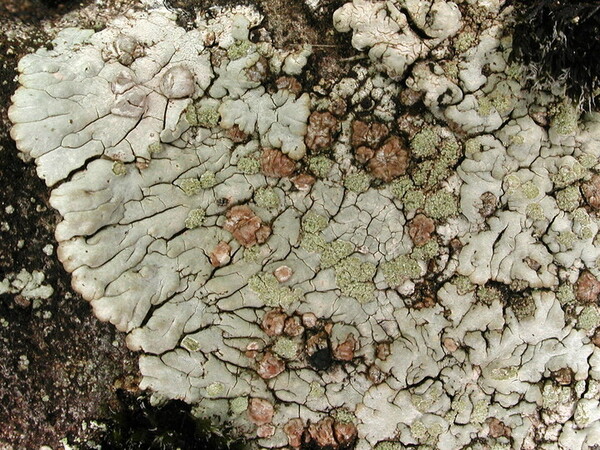Placopsis gelida (L.) Linds.
Trans. Linn. Soc. London, 25: 536, 1866. Basionym: Lichen gelidus L. - Mantissa Pl., 1: 133, 1767.
Synonyms: Lecanora gelida (L.) Ach.; Lecanora gelida f. neglecta Degel.; Placodium gelidum (L.) Gray; Squamaria gelida (L.) Hook.
Distribution: N - Piem.
Description: Thallus crustose-placodioid, sorediate, whitish to cream-coloured, dull except sometimes at the tips of lobes, forming orbicular, up to 4(-5) cm wide rosettes, the central part rimose-areolate, with concave, whitish grey or greenish, maculiform, more or less eroded soralia, and 0.5-4 mm wide, flesh-coloured to reddish brown, dichotomously lobed cephalodia, the marginal part with 0.5-1.5(-2) mm wide, elongated, contiguous, radiating lobes which are usually broader at tips. Cortex paraplectenchymatous; medulla white, I-. Apothecia rare, lecanorine, sessile, (0.3-)0.5-1.5(-1.8) mm across, with a flat, pinkish brown to dark reddish brown, often pruinose disc and a thick, persistent thalline margin. Proper exciple very thin, colourless; epithecium yellowish brown; hymenium colourless, I+ blue; paraphyses easily made free, thin, branched and anastomosing, submoniliform in upper part; hypothecium colourless. Asci 8-spored, cylindrical to narrowly clavate, amyloid, with a K/I+ pale blue tholus and a narrow, internal darker blue cap, approaching the Trapelia-type, but without an amyloid ring-structure. Ascospores 1-celled, hyaline, ellipsoid, 11-18 x 6-12 µm. Pycnidia rare, immersed in the thallus, with brown walls. Conidia thread-like, 15-25 x c. 0.5 µm. Photobiont chlorococcoid; cephalodia with Stigonema. Spot tests: K-, C+ red, KC+ red, P-. Chemistry: gyrophoric acid (major), lecanoric and hiascic acids (minor or traces).Note: a boreal-montane to arctic-alpine, incompletely circumpolar lichen found on small siliceous pebbles and on basal parts of large boulders, mostly in moist situations of the upper montane and subalpine belts; very rare and confined to the Alps in Italy.
Growth form: Crustose
Substrata: rocks
Photobiont: green algae other than Trentepohlia (primary); cyanobacteria, filamentous (e.g. Nostoc, Scytonema) (secundary, e.g. in cephalodia)
Reproductive strategy: mainly asexual, by soredia, or soredia-like structures (e.g. blastidia)
Most common in areas with a humid-warm climate (e.g. most of Tyrrenian Italy)
Commonnes-rarity: (info)
Alpine belt: absent
Subalpine belt: extremely rare
Oromediterranean belt: absent
Montane belt: extremely rare
Submediterranean belt: absent
Padanian area: absent
Humid submediterranean belt: absent
Humid mediterranean belt: absent
Dry mediterranean belt: absent
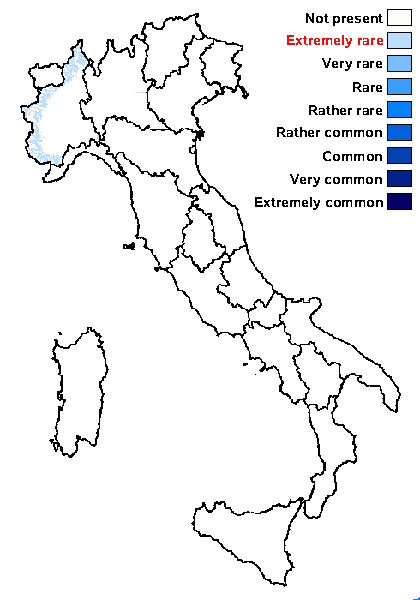
Predictive model
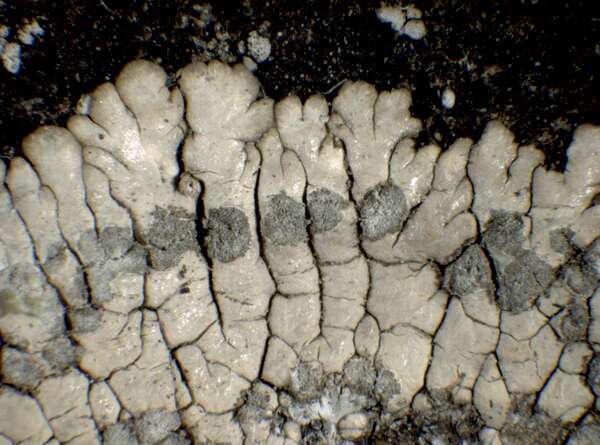

P.L. Nimis; Owner: Department of Life Sciences, University of Trieste
Herbarium: TSB (16484)
2001/12/18
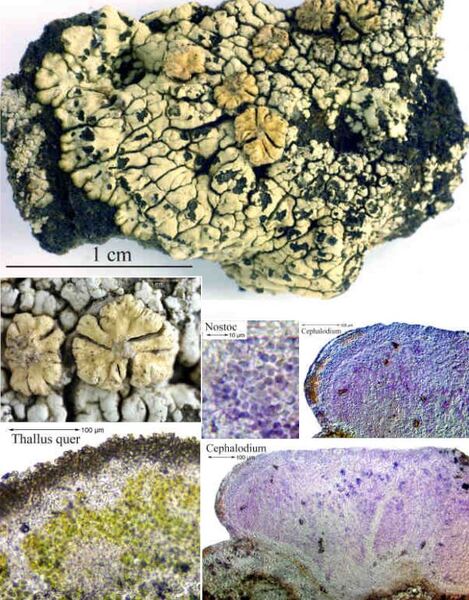

Felix Schumm – CC BY-SA 4.0
Image from: F. Schumm (2008) - Flechten Madeiras, der Kanaren und Azoren. Beck, OHG - ISBN: 978-3-00-023700-3
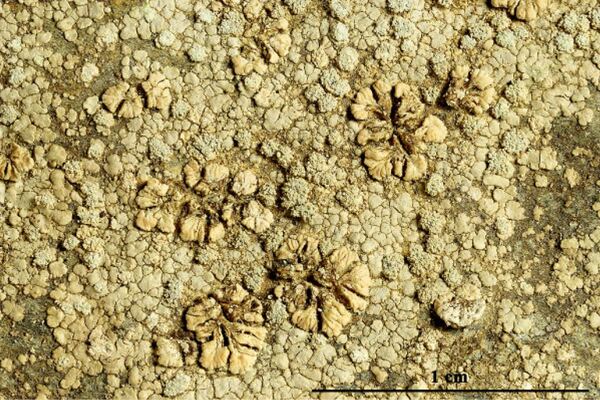

Felix Schumm - CC BY-SA 4.0
[19220], Australia, Victoria, Errinundra Road, 24 km S of Bendoc, 37°22' S, 148°53' E, 800 m, on rocks in road cutting, in Atherosperma forest. Leg. J.A. Elix (21841) & H. Streimann, 30.03.1988. LICH. AUSTRALASICI EXS. 165.
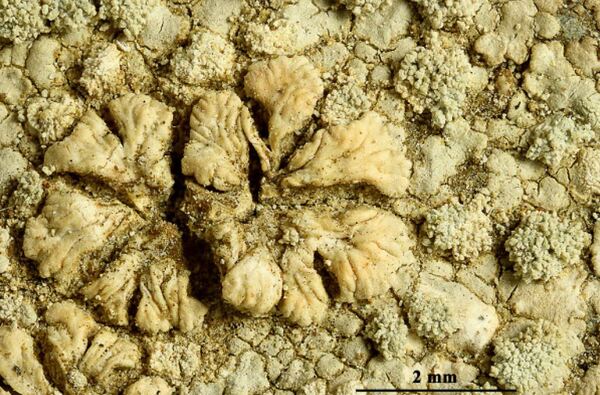

Felix Schumm - CC BY-SA 4.0
[19220], Australia, Victoria, Errinundra Road, 24 km S of Bendoc, 37°22' S, 148°53' E, 800 m, on rocks in road cutting, in Atherosperma forest. Leg. J.A. Elix (21841) & H. Streimann, 30.03.1988. LICH. AUSTRALASICI EXS. 165.


Felix Schumm - CC BY-SA 4.0
[19220], Australia, Victoria, Errinundra Road, 24 km S of Bendoc, 37°22' S, 148°53' E, 800 m, on rocks in road cutting, in Atherosperma forest. Leg. J.A. Elix (21841) & H. Streimann, 30.03.1988. LICH. AUSTRALASICI EXS. 165.
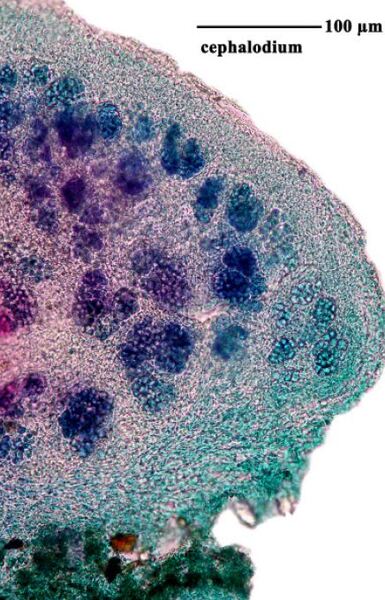

Felix Schumm - CC BY-SA 4.0
[19220], Australia, Victoria, Errinundra Road, 24 km S of Bendoc, 37°22' S, 148°53' E, 800 m, on rocks in road cutting, in Atherosperma forest. Leg. J.A. Elix (21841) & H. Streimann, 30.03.1988. LICH. AUSTRALASICI EXS. 165.
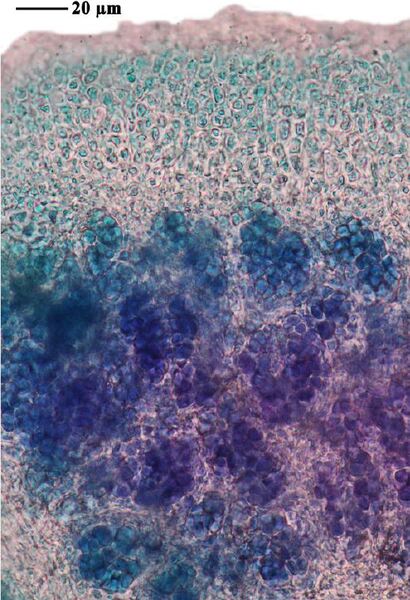

Felix Schumm - CC BY-SA 4.0
[19220], Australia, Victoria, Errinundra Road, 24 km S of Bendoc, 37°22' S, 148°53' E, 800 m, on rocks in road cutting, in Atherosperma forest. Leg. J.A. Elix (21841) & H. Streimann, 30.03.1988. LICH. AUSTRALASICI EXS. 165.
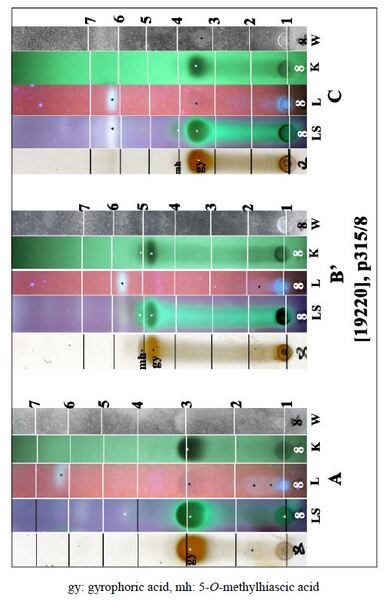

Felix Schumm - CC BY-SA 4.0
[19220], Australia, Victoria, Errinundra Road, 24 km S of Bendoc, 37°22' S, 148°53' E, 800 m, on rocks in road cutting, in Atherosperma forest. Leg. J.A. Elix (21841) & H. Streimann, 30.03.1988. LICH. AUSTRALASICI EXS. 165.
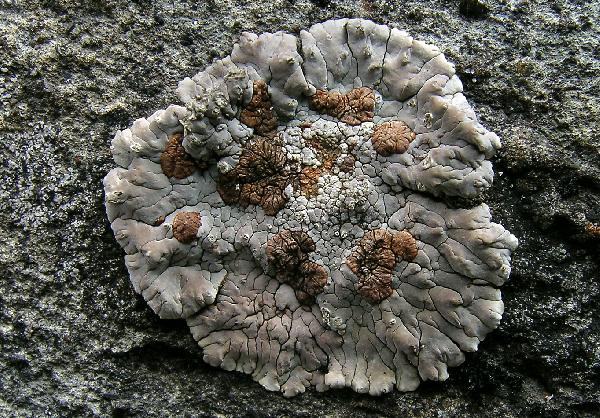
Ulrich Kirschbaum CC BY-SA 4.0 - Source: https://www.thm.de/lse/ulrich-kirschbaum/flechtenbilder
Portugal: Madeira.
Growth form: Crustose
Substrata: rocks
Photobiont: green algae other than Trentepohlia (primary); cyanobacteria, filamentous (e.g. Nostoc, Scytonema) (secundary, e.g. in cephalodia)
Reproductive strategy: mainly asexual, by soredia, or soredia-like structures (e.g. blastidia)
Most common in areas with a humid-warm climate (e.g. most of Tyrrenian Italy)
Commonnes-rarity: (info)
Alpine belt: absent
Subalpine belt: extremely rare
Oromediterranean belt: absent
Montane belt: extremely rare
Submediterranean belt: absent
Padanian area: absent
Humid submediterranean belt: absent
Humid mediterranean belt: absent
Dry mediterranean belt: absent

Predictive model


P.L. Nimis; Owner: Department of Life Sciences, University of Trieste
Herbarium: TSB (16484)
2001/12/18


Felix Schumm – CC BY-SA 4.0
Image from: F. Schumm (2008) - Flechten Madeiras, der Kanaren und Azoren. Beck, OHG - ISBN: 978-3-00-023700-3


Felix Schumm - CC BY-SA 4.0
[19220], Australia, Victoria, Errinundra Road, 24 km S of Bendoc, 37°22' S, 148°53' E, 800 m, on rocks in road cutting, in Atherosperma forest. Leg. J.A. Elix (21841) & H. Streimann, 30.03.1988. LICH. AUSTRALASICI EXS. 165.


Felix Schumm - CC BY-SA 4.0
[19220], Australia, Victoria, Errinundra Road, 24 km S of Bendoc, 37°22' S, 148°53' E, 800 m, on rocks in road cutting, in Atherosperma forest. Leg. J.A. Elix (21841) & H. Streimann, 30.03.1988. LICH. AUSTRALASICI EXS. 165.


Felix Schumm - CC BY-SA 4.0
[19220], Australia, Victoria, Errinundra Road, 24 km S of Bendoc, 37°22' S, 148°53' E, 800 m, on rocks in road cutting, in Atherosperma forest. Leg. J.A. Elix (21841) & H. Streimann, 30.03.1988. LICH. AUSTRALASICI EXS. 165.


Felix Schumm - CC BY-SA 4.0
[19220], Australia, Victoria, Errinundra Road, 24 km S of Bendoc, 37°22' S, 148°53' E, 800 m, on rocks in road cutting, in Atherosperma forest. Leg. J.A. Elix (21841) & H. Streimann, 30.03.1988. LICH. AUSTRALASICI EXS. 165.


Felix Schumm - CC BY-SA 4.0
[19220], Australia, Victoria, Errinundra Road, 24 km S of Bendoc, 37°22' S, 148°53' E, 800 m, on rocks in road cutting, in Atherosperma forest. Leg. J.A. Elix (21841) & H. Streimann, 30.03.1988. LICH. AUSTRALASICI EXS. 165.


Felix Schumm - CC BY-SA 4.0
[19220], Australia, Victoria, Errinundra Road, 24 km S of Bendoc, 37°22' S, 148°53' E, 800 m, on rocks in road cutting, in Atherosperma forest. Leg. J.A. Elix (21841) & H. Streimann, 30.03.1988. LICH. AUSTRALASICI EXS. 165.

 INDEX FUNGORUM
INDEX FUNGORUM
 GBIF
GBIF
